automatic transmission MERCEDES-BENZ CL-Class 2012 C216 Owner's Manual
[x] Cancel search | Manufacturer: MERCEDES-BENZ, Model Year: 2012, Model line: CL-Class, Model: MERCEDES-BENZ CL-Class 2012 C216Pages: 488, PDF Size: 21.88 MB
Page 7 of 488
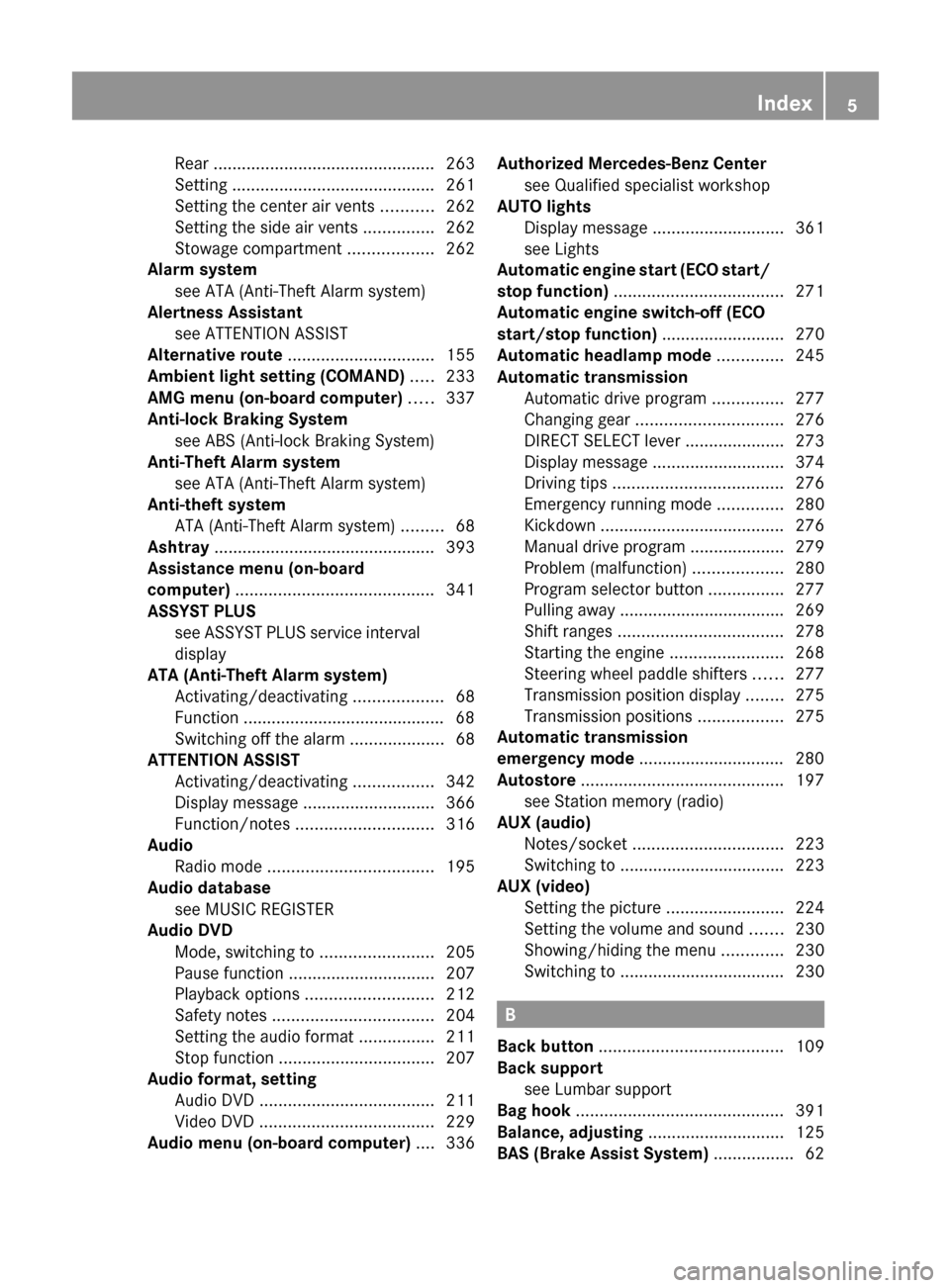
Rear ............................................... 263
Setting ........................................... 261
Setting the center air vents ...........262
Setting the side air vents ...............262
Stowage compartment ..................262
Alarm system
see ATA (Anti-Theft Alarm system)
Alertness Assistant
see ATTENTION ASSIST
Alternative route ............................... 155
Ambient light setting (COMAND) ..... 233
AMG menu (on-board computer) ..... 337
Anti-lock Braking System see ABS (Anti-lock Braking System)
Anti-Theft Alarm system
see ATA (Anti-Theft Alarm system)
Anti-theft system
ATA (Anti-Theft Alarm system) .........68
Ashtray ............................................... 393
Assistance menu (on-board
computer) .......................................... 341
ASSYST PLUS see ASSYST PLUS service interval
display
ATA (Anti-Theft Alarm system)
Activating/deactivating ...................68
Function ........................................... 68
Switching off the alarm ....................68
ATTENTION ASSIST
Activating/deactivating .................342
Display message ............................ 366
Function/notes ............................. 316
Audio
Radio mode ................................... 195
Audio database
see MUSIC REGISTER
Audio DVD
Mode, switching to ........................205
Pause function ............................... 207
Playback options ........................... 212
Safety notes .................................. 204
Setting the audio format ................211
Stop function ................................. 207
Audio format, setting
Audio DVD ..................................... 211
Video DVD ..................................... 229
Audio menu (on-board computer) .... 336Authorized Mercedes-Benz Center
see Qualified specialist workshop
AUTO lights
Display message ............................ 361
see Lights
Automatic engine start (ECO start/
stop function) .................................... 271
Automatic engine switch-off (ECO
start/stop function) .......................... 270
Automatic headlamp mode .............. 245
Automatic transmission Automatic drive program ...............277
Changing gear ............................... 276
DIRECT SELECT lever .....................273
Display message ............................ 374
Driving tips .................................... 276
Emergency running mode ..............280
Kickdown ....................................... 276
Manual drive program ....................279
Problem (malfunction) ...................280
Program selector button ................277
Pulling away ................................... 269
Shift ranges ................................... 278
Starting the engine ........................268
Steering wheel paddle shifters ......277
Transmission position display ........275
Transmission positions ..................275
Automatic transmission
emergency mode ............................... 280
Autostore ........................................... 197
see Station memory (radio)
AUX (audio)
Notes/socket ................................ 223
Switching to ................................... 223
AUX (video)
Setting the picture .........................224
Setting the volume and sound .......230
Showing/hiding the menu .............230
Switching to ................................... 230
B
Back button ....................................... 109
Back support see Lumbar support
Bag hook ............................................ 391
Balance, adjusting ............................. 125
BAS (Brake Assist System) ................. 62
Index5
Page 11 of 488
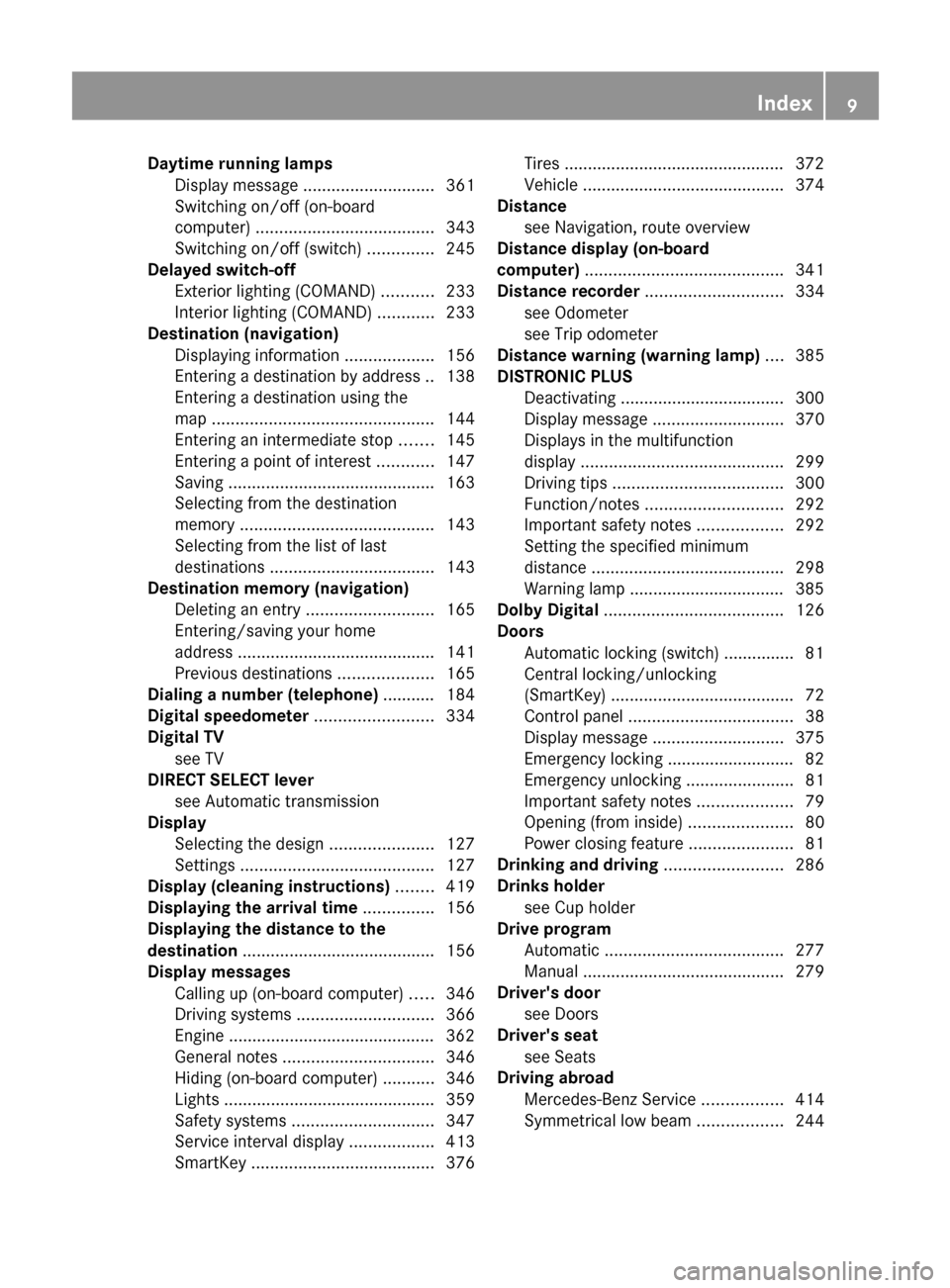
Daytime running lampsDisplay message ............................ 361
Switching on/off (on-board
computer) ...................................... 343
Switching on/off (switch) ..............245
Delayed switch-off
Exterior lighting (COMAND) ...........233
Interior lighting (COMAND) ............233
Destination (navigation)
Displaying information ...................156
Entering a destination by address .. 138
Entering a destination using the
map ............................................... 144
Entering an intermediate stop .......145
Entering a point of interest ............147
Saving ............................................ 163
Selecting from the destination
memory ......................................... 143
Selecting from the list of last
destinations ................................... 143
Destination memory (navigation)
Deleting an entry ........................... 165
Entering/saving your home
address .......................................... 141
Previous destinations ....................165
Dialing a number (telephone) ........... 184
Digital speedometer ......................... 334
Digital TV see TV
DIRECT SELECT lever
see Automatic transmission
Display
Selecting the design ......................127
Settings ......................................... 127
Display (cleaning instructions) ........ 419
Displaying the arrival time ............... 156
Displaying the distance to the
destination ......................................... 156
Display messages Calling up (on-board computer) .....346
Driving systems ............................. 366
Engine ............................................ 362
General notes ................................ 346
Hiding (on-board computer) ...........346
Lights ............................................. 359
Safety systems .............................. 347
Service interval display ..................413
SmartKey ....................................... 376Tires ............................................... 372
Vehicle ........................................... 374
Distance
see Navigation, route overview
Distance display (on-board
computer) .......................................... 341
Distance recorder ............................. 334
see Odometer
see Trip odometer
Distance warning (warning lamp) .... 385
DISTRONIC PLUS Deactivating ................................... 300
Display message ............................ 370
Displays in the multifunction
display ........................................... 299
Driving tips .................................... 300
Function/notes ............................. 292
Important safety notes ..................292
Setting the specified minimum
distance ......................................... 298
Warning lamp ................................. 385
Dolby Digital ...................................... 126
Doors Automatic locking (switch) ............... 81
Central locking/unlocking
(SmartKey) ....................................... 72
Control panel ................................... 38
Display message ............................ 375
Emergency locking ........................... 82
Emergency unlocking .......................81
Important safety notes ....................79
Opening (from inside) ......................80
Power closing feature ......................81
Drinking and driving ......................... 286
Drinks holder see Cup holder
Drive program
Automatic ...................................... 277
Manual ........................................... 279
Driver's door
see Doors
Driver's seat
see Seats
Driving abroad
Mercedes-Benz Service .................414
Symmetrical low beam ..................244Index9
Page 12 of 488
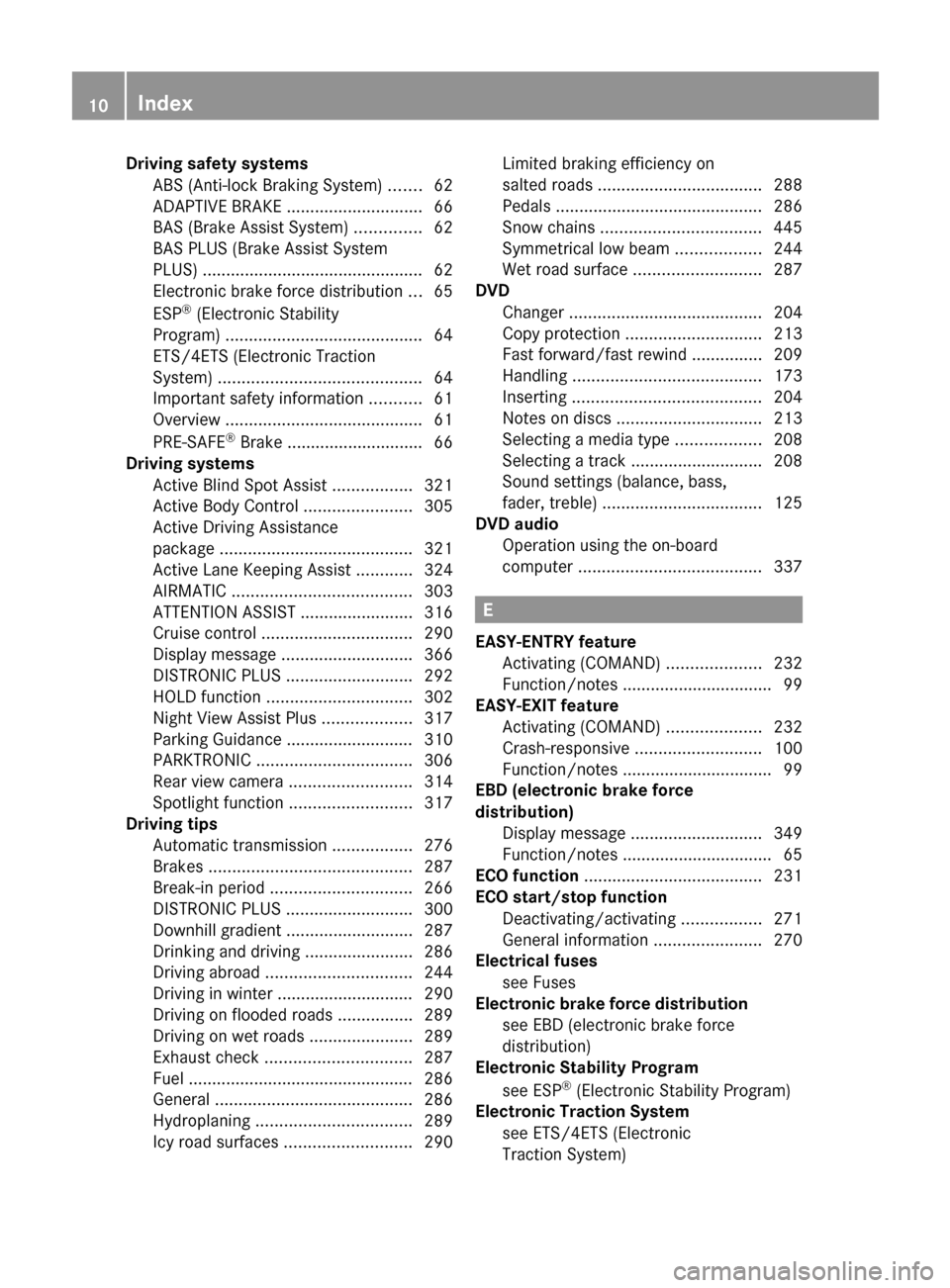
Driving safety systemsABS (Anti-lock Braking System) .......62
ADAPTIVE BRAKE ............................. 66
BAS (Brake Assist System) ..............62
BAS PLUS (Brake Assist System
PLUS) ............................................... 62
Electronic brake force distribution ...65
ESP ®
(Electronic Stability
Program) .......................................... 64
ETS/4ETS (Electronic Traction
System) ........................................... 64
Important safety information ...........61
Overview .......................................... 61
PRE-SAFE ®
Brake ............................. 66
Driving systems
Active Blind Spot Assist .................321
Active Body Control .......................305
Active Driving Assistance
package ......................................... 321
Active Lane Keeping Assist ............324
AIRMATIC ...................................... 303
ATTENTION ASSIST ........................316
Cruise control ................................ 290
Display message ............................ 366
DISTRONIC PLUS ........................... 292
HOLD function ............................... 302
Night View Assist Plus ...................317
Parking Guidance ........................... 310
PARKTRONIC ................................. 306
Rear view camera .......................... 314
Spotlight function .......................... 317
Driving tips
Automatic transmission .................276
Brakes ........................................... 287
Break-in period .............................. 266
DISTRONIC PLUS ........................... 300
Downhill gradient ........................... 287
Drinking and driving .......................286
Driving abroad ............................... 244
Driving in winter ............................. 290
Driving on flooded roads ................289
Driving on wet roads ......................289
Exhaust check ............................... 287
Fuel ................................................ 286
General .......................................... 286
Hydroplaning ................................. 289
Icy road surfaces ........................... 290Limited braking efficiency on
salted roads ................................... 288
Pedals ............................................ 286
Snow chains .................................. 445
Symmetrical low beam ..................244
Wet road surface ........................... 287
DVD
Changer ......................................... 204
Copy protection ............................. 213
Fast forward/fast rewind ...............209
Handling ........................................ 173
Inserting ........................................ 204
Notes on discs ............................... 213
Selecting a media type ..................208
Selecting a track ............................ 208
Sound settings (balance, bass,
fader, treble) .................................. 125
DVD audio
Operation using the on-board
computer ....................................... 337
E
EASY-ENTRY feature Activating (COMAND) ....................232
Function/notes ................................ 99
EASY-EXIT feature
Activating (COMAND) ....................232
Crash-responsive ........................... 100
Function/notes ................................ 99
EBD (electronic brake force
distribution) Display message ............................ 349
Function/notes ................................ 65
ECO function ...................................... 231
ECO start/stop function Deactivating/activating .................271
General information .......................270
Electrical fuses
see Fuses
Electronic brake force distribution
see EBD (electronic brake force
distribution)
Electronic Stability Program
see ESP ®
(Electronic Stability Program)
Electronic Traction System
see ETS/4ETS (Electronic
Traction System)
10Index
Page 20 of 488
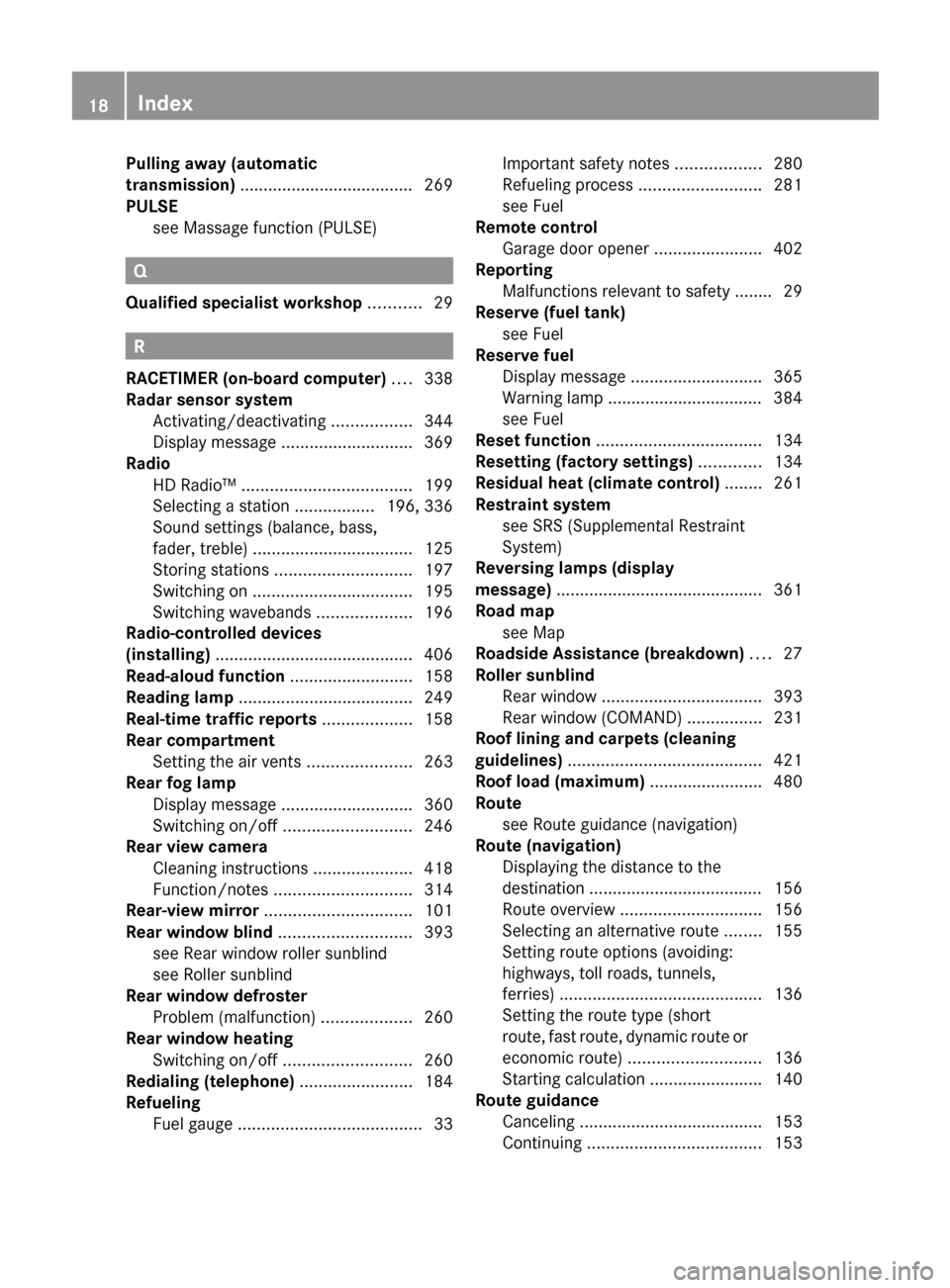
Pulling away (automatic
transmission) ..................................... 269
PULSE see Massage function (PULSE)
Q
Qualified specialist workshop ........... 29
R
RACETIMER (on-board computer) .... 338
Radar sensor system Activating/deactivating .................344
Display message ............................ 369
Radio
HD Radio™ .................................... 199
Selecting a station .................196, 336
Sound settings (balance, bass,
fader, treble) .................................. 125
Storing stations ............................. 197
Switching on .................................. 195
Switching wavebands ....................196
Radio-controlled devices
(installing) .......................................... 406
Read-aloud function .......................... 158
Reading lamp ..................................... 249
Real-time traffic reports ................... 158
Rear compartment Setting the air vents ......................263
Rear fog lamp
Display message ............................ 360
Switching on/off ........................... 246
Rear view camera
Cleaning instructions .....................418
Function/notes ............................. 314
Rear-view mirror ............................... 101
Rear window blind ............................ 393
see Rear window roller sunblind
see Roller sunblind
Rear window defroster
Problem (malfunction) ...................260
Rear window heating
Switching on/off ........................... 260
Redialing (telephone) ........................ 184
Refueling Fuel gauge ....................................... 33
Important safety notes ..................280
Refueling process ..........................281
see Fuel
Remote control
Garage door opener .......................402
Reporting
Malfunctions relevant to safety ........ 29
Reserve (fuel tank)
see Fuel
Reserve fuel
Display message ............................ 365
Warning lamp ................................. 384
see Fuel
Reset function ................................... 134
Resetting (factory settings) ............. 134
Residual heat (climate control) ........ 261
Restraint system see SRS (Supplemental Restraint
System)
Reversing lamps (display
message) ............................................ 361
Road map see Map
Roadside Assistance (breakdown) .... 27
Roller sunblind Rear window .................................. 393
Rear window (COMAND) ................231
Roof lining and carpets (cleaning
guidelines) ......................................... 421
Roof load (maximum) ........................ 480
Route see Route guidance (navigation)
Route (navigation)
Displaying the distance to the
destination ..................................... 156
Route overview .............................. 156
Selecting an alternative route ........155
Setting route options (avoiding:
highways, toll roads, tunnels,
ferries) ........................................... 136
Setting the route type (short
route, fast route, dynamic route or
economic route) ............................ 136
Starting calculation ........................140
Route guidance
Canceling ....................................... 153
Continuing ..................................... 15318Index
Page 25 of 488
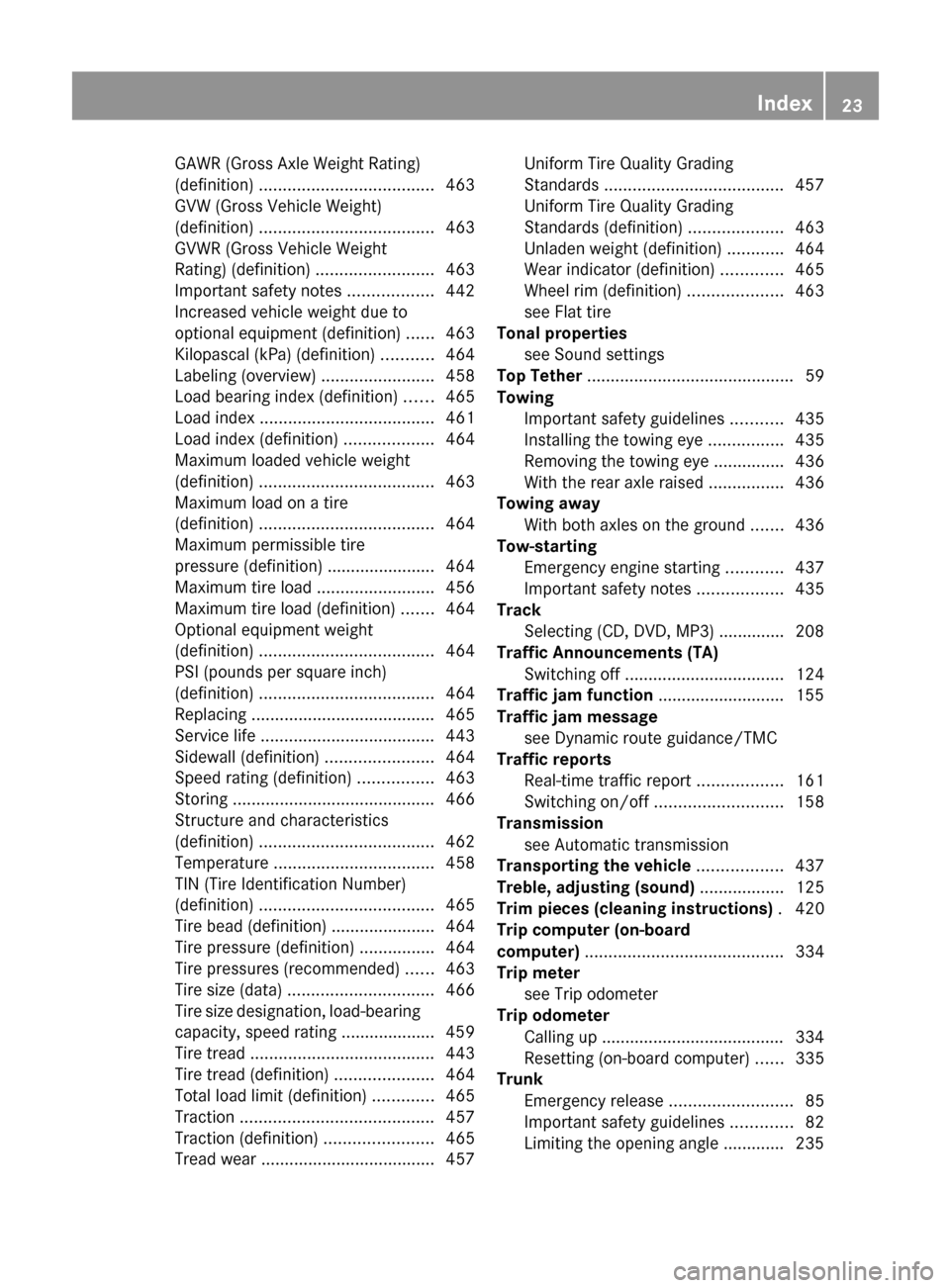
GAWR (Gross Axle Weight Rating)
(definition) ..................................... 463
GVW (Gross Vehicle Weight)
(definition) ..................................... 463
GVWR (Gross Vehicle Weight
Rating) (definition) .........................463
Important safety notes ..................442
Increased vehicle weight due to
optional equipment (definition) ......463
Kilopascal (kPa) (definition) ...........464
Labeling (overview) ........................458
Load bearing index (definition) ......465
Load index ..................................... 461
Load index (definition) ...................464
Maximum loaded vehicle weight
(definition) ..................................... 463
Maximum load on a tire
(definition) ..................................... 464
Maximum permissible tire
pressure (definition) ....................... 464
Maximum tire load .........................456
Maximum tire load (definition) .......464
Optional equipment weight
(definition) ..................................... 464
PSI (pounds per square inch)
(definition) ..................................... 464
Replacing ....................................... 465
Service life ..................................... 443
Sidewall (definition) .......................464
Speed rating (definition) ................463
Storing ........................................... 466
Structure and characteristics
(definition) ..................................... 462
Temperature .................................. 458
TIN (Tire Identification Number)
(definition) ..................................... 465
Tire bead (definition) ......................464
Tire pressure (definition) ................464
Tire pressures (recommended) ......463
Tire size (data) ............................... 466
Tire size designation, load-bearing
capacity, speed rating .................... 459
Tire tread ....................................... 443
Tire tread (definition) .....................464
Total load limit (definition) .............465
Traction ......................................... 457
Traction (definition) .......................465
Tread wear ..................................... 457Uniform Tire Quality Grading
Standards ...................................... 457
Uniform Tire Quality Grading
Standards (definition) ....................463
Unladen weight (definition) ............464
Wear indicator (definition) .............465
Wheel rim (definition) ....................463
see Flat tire
Tonal properties
see Sound settings
Top Tether ............................................ 59
Towing Important safety guidelines ...........435
Installing the towing eye ................435
Removing the towing eye ...............436
With the rear axle raised ................436
Towing away
With both axles on the ground .......436
Tow-starting
Emergency engine starting ............437
Important safety notes ..................435
Track
Selecting (CD, DVD, MP3) .............. 208
Traffic Announcements (TA)
Switching off .................................. 124
Traffic jam function ........................... 155
Traffic jam message see Dynamic route guidance/TMC
Traffic reports
Real-time traffic report ..................161
Switching on/off ........................... 158
Transmission
see Automatic transmission
Transporting the vehicle .................. 437
Treble, adjusting (sound) .................. 125
Trim pieces (cleaning instructions) . 420
Trip computer (on-board
computer) .......................................... 334
Trip meter see Trip odometer
Trip odometer
Calling up ....................................... 334
Resetting (on-board computer) ......335
Trunk
Emergency release ..........................85
Important safety guidelines .............82
Limiting the opening angle ............. 235Index23
Page 76 of 488

This device complies with RSS-210 of
Industry Canada. Operation is subject to
the following two conditions:
1. This device may not cause harmful
interference, and
2. this device must accept any interference
received, including interference that may
cause undesired operation.
Any unauthorized modification to this
device could void the user’s authority to
operate the equipment.
The Product label with FCC ID and IC
certification number can be found in the
battery case of the SmartKey.
Important notes on the use of KEYLESS-
GO
R The KEYLESS-GO key can be used like a
conventional key.
R You can combine KEYLESS-GO functions
with those of a conventional key, e.g.
unlock with KEYLESS-GO and lock with the
& button.
R Always carry your KEYLESS-GO key on your
person.
R Do not keep the KEYLESS-GO key together
with:
- electronic devices, e.g. a mobile phone
or another key
- metallic objects, e.g. coins or metal foil.
This can affect the functionality of
KEYLESS-GO.
R When locking and unlocking using
KEYLESS-GO, the distance between the
SmartKey and the corresponding door
handle must not exceed 3 ft (1 m).
R If the vehicle is parked for more than
72 hours, the KEYLESS-GO function is
deactivated. Pull the outer door handle and
switch on the ignition to reactivate the
KEYLESS-GO function.
R If the KEYLESS-GO key is removed from the
vehicle, it is possible that the system may
not recognize the SmartKey. The vehicle
can then not be locked or started using
KEYLESS-GO.
R If the KEYLESS-GO key has been removed
from the vehicle, e.g. if a passenger leaves
the vehicle with a KEYLESS-GO key:
- if the start/stop button is pressed or if
an attempt is made to lock the vehicle
with the locking button on the outer door
handle, the Key Not Detected message
appears in the multifunction display
- when the engine is running, the red Key
Not Detected message appears in the
multifunction display as you pull away.
Find the KEYLESS-GO key and change its
position in the vehicle. Carry the
KEYLESS-GO key in your shirt pocket, for
example.
R If you have started the engine with the
Start/Stop button, you can switch it off
again by:
- pressing the Start/Stop button again
- inserting the KEYLESS-GO key into the
ignition lock if the vehicle is stationary
and the automatic transmission is in park
position P.
R You could unlock the vehicle by mistake if
the distance between the KEYLESS-GO key
and the vehicle is less than 3 ft (1 m) and:
- an exterior door handle is hit by a water
jet
or
- you clean an exterior door handle.
R Bear in mind that the engine can be started
by any of the vehicle occupants if there is
a KEYLESS-GO key in the vehicle.74SmartKeyOpening/closing
Page 190 of 488
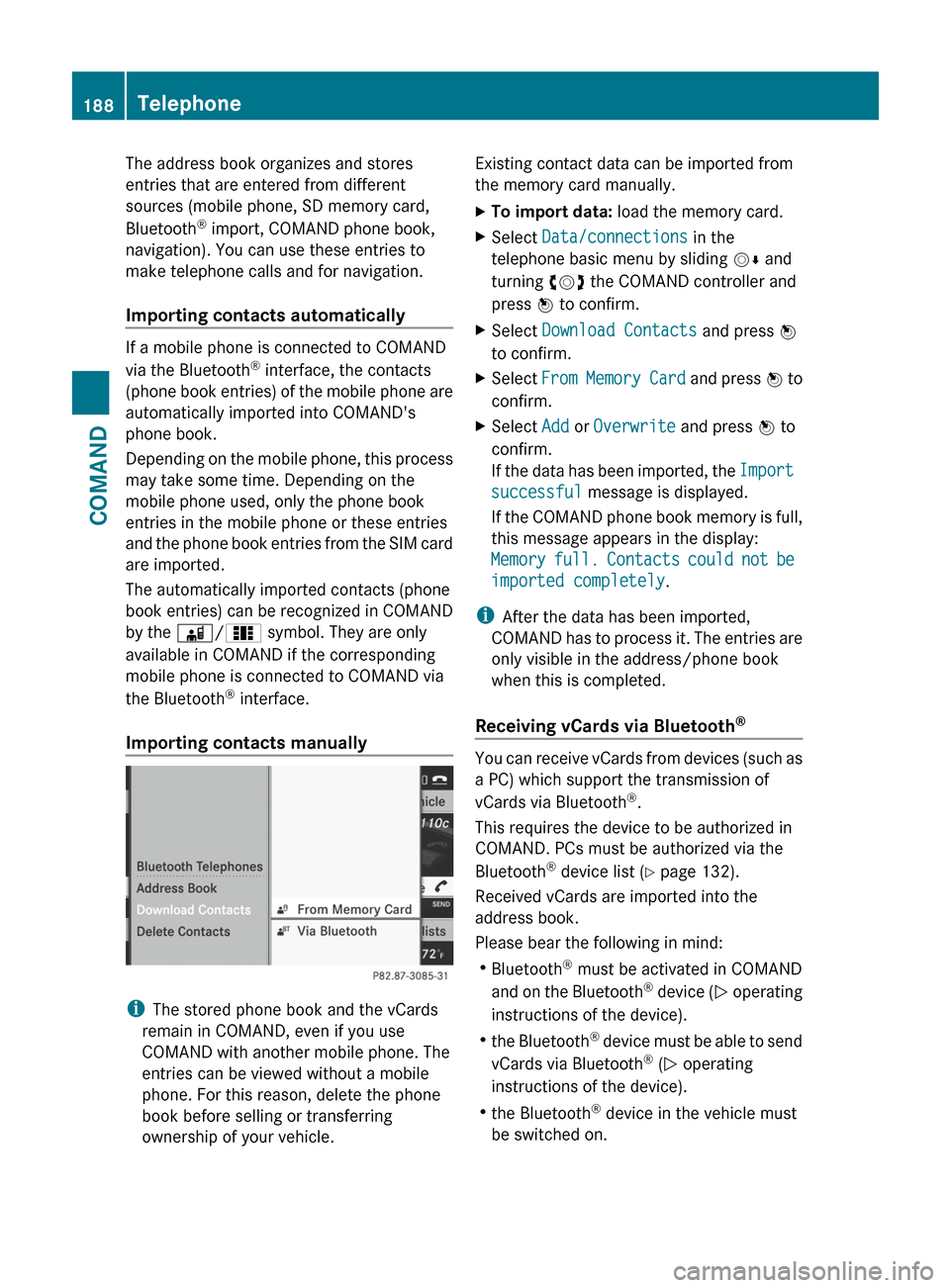
The address book organizes and stores
entries that are entered from different
sources (mobile phone, SD memory card,
Bluetooth ®
import, COMAND phone book,
navigation). You can use these entries to
make telephone calls and for navigation.
Importing contacts automatically
If a mobile phone is connected to COMAND
via the Bluetooth ®
interface, the contacts
(phone book entries) of the mobile phone are
automatically imported into COMAND's
phone book.
Depending on the mobile phone, this process
may take some time. Depending on the
mobile phone used, only the phone book
entries in the mobile phone or these entries
and the phone book entries from the SIM card
are imported.
The automatically imported contacts (phone
book entries) can be recognized in COMAND
by the Ã/0 symbol. They are only
available in COMAND if the corresponding
mobile phone is connected to COMAND via
the Bluetooth ®
interface.
Importing contacts manually
i The stored phone book and the vCards
remain in COMAND, even if you use
COMAND with another mobile phone. The
entries can be viewed without a mobile
phone. For this reason, delete the phone
book before selling or transferring
ownership of your vehicle.
Existing contact data can be imported from
the memory card manually.XTo import data: load the memory card.XSelect Data/connections in the
telephone basic menu by sliding VÆ and
turning cVd the COMAND controller and
press W to confirm.XSelect Download Contacts and press W
to confirm.XSelect From Memory Card and press W to
confirm.XSelect Add or Overwrite and press W to
confirm.
If the data has been imported, the Import
successful message is displayed.
If the COMAND phone book memory is full,
this message appears in the display:
Memory full. Contacts could not be
imported completely .
i
After the data has been imported,
COMAND has to process it. The entries are
only visible in the address/phone book
when this is completed.
Receiving vCards via Bluetooth ®
You can receive vCards from devices (such as
a PC) which support the transmission of
vCards via Bluetooth ®
.
This requires the device to be authorized in
COMAND. PCs must be authorized via the
Bluetooth ®
device list ( Y page 132).
Received vCards are imported into the
address book.
Please bear the following in mind:
R Bluetooth ®
must be activated in COMAND
and on the Bluetooth ®
device ( N operating
instructions of the device).
R the Bluetooth ®
device must be able to send
vCards via Bluetooth ®
(N operating
instructions of the device).
R the Bluetooth ®
device in the vehicle must
be switched on.
188TelephoneCOMAND
Page 267 of 488
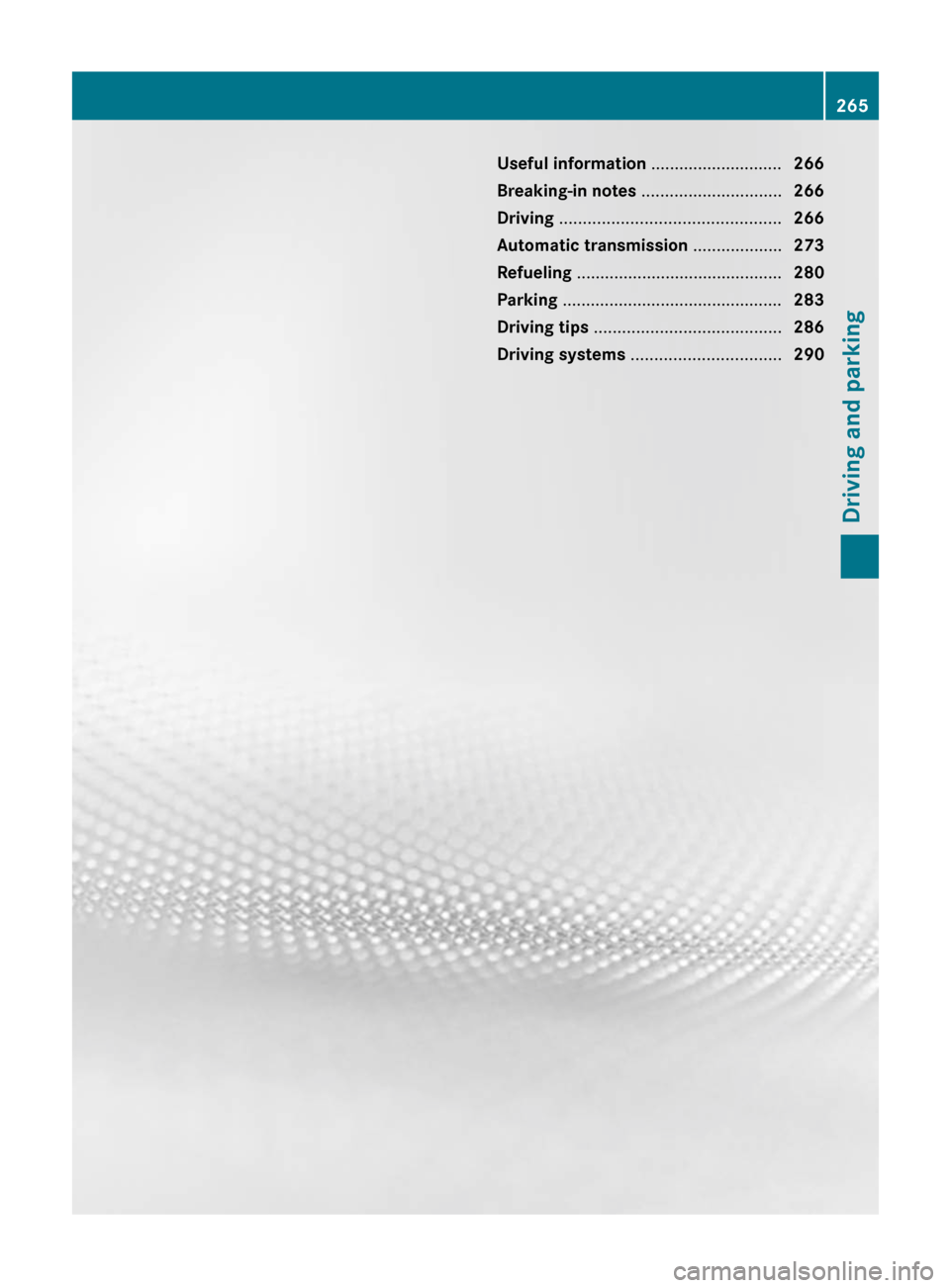
Useful information ............................266
Breaking-in notes .............................. 266
Driving ............................................... 266
Automatic transmission ...................273
Refueling ............................................ 280
Parking ............................................... 283
Driving tips ........................................ 286
Driving systems ................................ 290265Driving and parking
Page 268 of 488
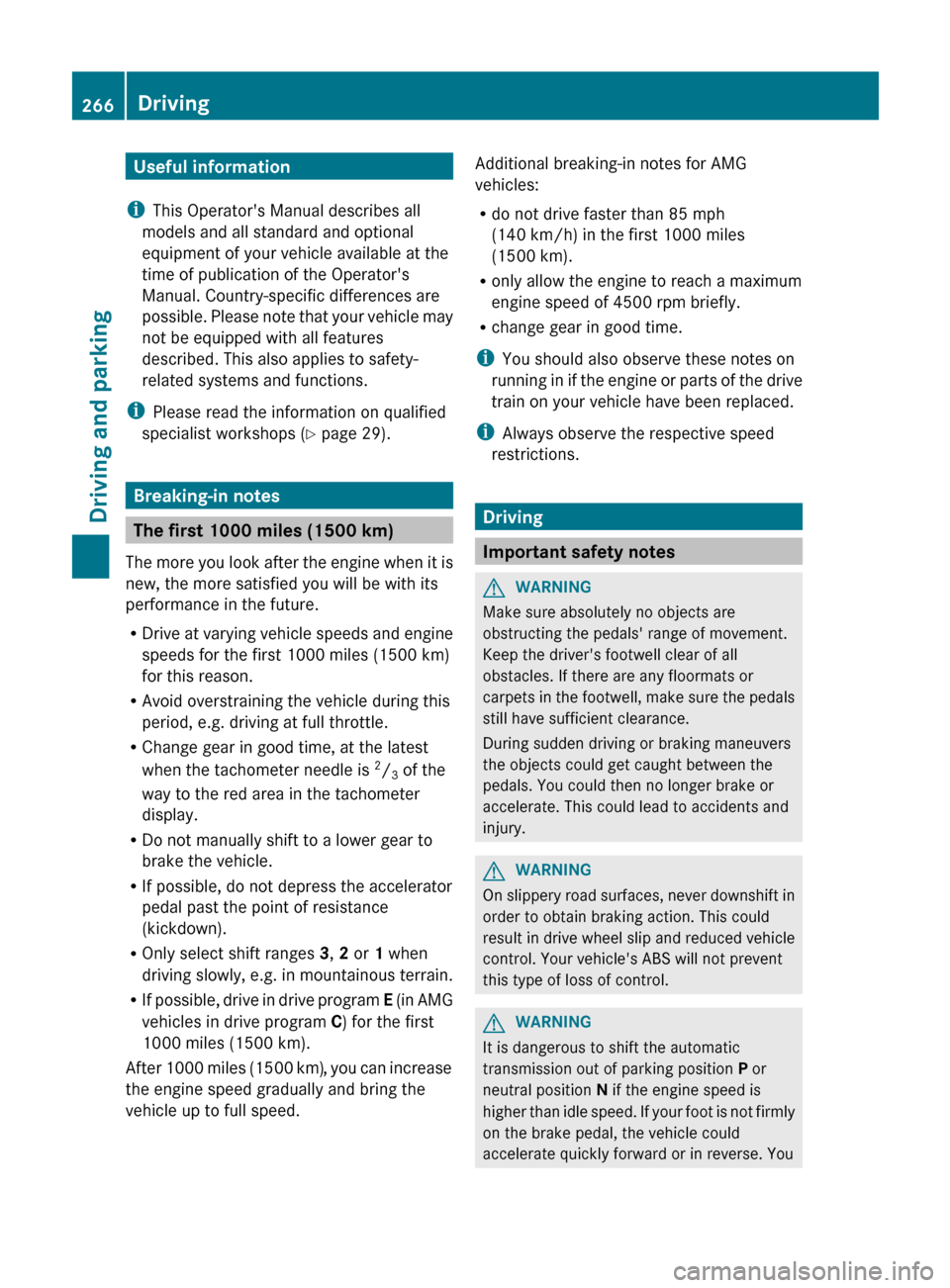
Useful information
i This Operator's Manual describes all
models and all standard and optional
equipment of your vehicle available at the
time of publication of the Operator's
Manual. Country-specific differences are
possible. Please note that your vehicle may
not be equipped with all features
described. This also applies to safety-
related systems and functions.
i Please read the information on qualified
specialist workshops ( Y page 29).
Breaking-in notes
The first 1000 miles (1500 km)
The more you look after the engine when it is
new, the more satisfied you will be with its
performance in the future.
R Drive at varying vehicle speeds and engine
speeds for the first 1000 miles (1500 km)
for this reason.
R Avoid overstraining the vehicle during this
period, e.g. driving at full throttle.
R Change gear in good time, at the latest
when the tachometer needle is 2
/ 3 of the
way to the red area in the tachometer
display.
R Do not manually shift to a lower gear to
brake the vehicle.
R If possible, do not depress the accelerator
pedal past the point of resistance
(kickdown).
R Only select shift ranges 3, 2 or 1 when
driving slowly, e.g. in mountainous terrain.
R If possible, drive in drive program E (in AMG
vehicles in drive program C) for the first
1000 miles (1500 km).
After 1000 miles (1500 km), you can increase
the engine speed gradually and bring the
vehicle up to full speed.
Additional breaking-in notes for AMG
vehicles:
R do not drive faster than 85 mph
(140 km/h) in the first 1000 miles
(1500 km).
R only allow the engine to reach a maximum
engine speed of 4500 rpm briefly.
R change gear in good time.
i You should also observe these notes on
running in if the engine or parts of the drive
train on your vehicle have been replaced.
i Always observe the respective speed
restrictions.
Driving
Important safety notes
GWARNING
Make sure absolutely no objects are
obstructing the pedals' range of movement.
Keep the driver's footwell clear of all
obstacles. If there are any floormats or
carpets in the footwell, make sure the pedals
still have sufficient clearance.
During sudden driving or braking maneuvers
the objects could get caught between the
pedals. You could then no longer brake or
accelerate. This could lead to accidents and
injury.
GWARNING
On slippery road surfaces, never downshift in
order to obtain braking action. This could
result in drive wheel slip and reduced vehicle
control. Your vehicle's ABS will not prevent
this type of loss of control.
GWARNING
It is dangerous to shift the automatic
transmission out of parking position P or
neutral position N if the engine speed is
higher than idle speed. If your foot is not firmly
on the brake pedal, the vehicle could
accelerate quickly forward or in reverse. You
266DrivingDriving and parking
Page 269 of 488

could lose control of the vehicle and hit
someone or something. Only shift into gear
when the engine is idling normally and when
your right foot is firmly on the brake pedal.
! Warm up the engine quickly. Do not use
the engine's full performance until it has
reached operating temperature.
Only shift the automatic transmission to
the desired drive position when the vehicle
is stationary.
Where possible, avoid spinning the drive
wheels when pulling away on slippery
roads. You could otherwise damage the
drive train.
! CL 63 AMG: at low engine oil
temperatures below 68 ‡ (+20 †), the
maximum engine speed is restricted in
order to protect the engine. To protect the
engine and maintain smooth engine
operation, avoid driving at full throttle when
the engine is cold.
SmartKey positions
SmartKey
gTo remove the SmartKey1Power supply for some consumers, such
as the windshield wipers2Ignition (power supply for all consumers)
and drive position3To start the engine
i The SmartKey can be turned in the
ignition lock even if it is not the correct
SmartKey for the vehicle. The ignition is not
switched on. The engine cannot be started.
KEYLESS-GO
General information
Vehicles with KEYLESS-GO are equipped with
a SmartKey featuring an integrated KEYLESS-
GO function and a detachable Start/Stop
button.
The Start/Stop button must be inserted into
the ignition lock and the SmartKey must be in
the vehicle.
Pressing the Start/Stop button several times
in succession corresponds to the different
SmartKey positions in the ignition lock. This
is only the case if you are not depressing the
brake pedal.
If you depress the brake pedal and press the
Start/Stop button, the engine starts
immediately.
The Start/Stop button can be removed from
the ignition lock. Then, you can insert the
SmartKey into the ignition lock.
i You do not have to remove the Start/Stop
button from the ignition lock when you
leave the vehicle. However, you should
always take the SmartKey with you when
leaving the vehicle. The vehicle can be
started with the Start/Stop button and the
electrical equipment can be operated while
the SmartKey is in the vehicle.
:Start/Stop button;Ignition lockDriving267Driving and parkingZ